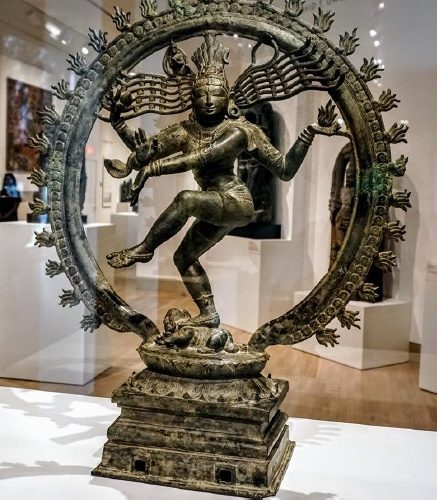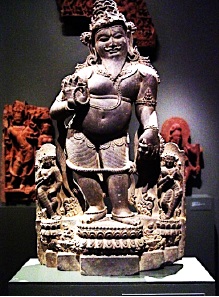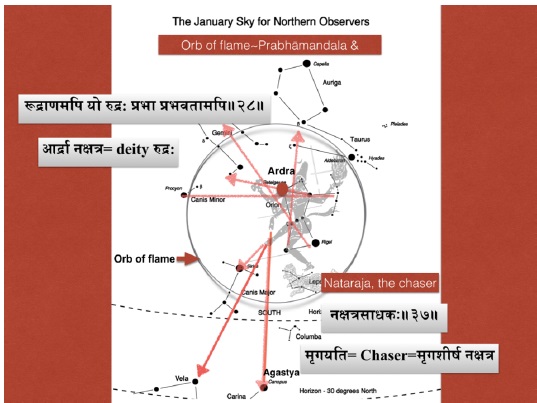This paper deals with understanding human’s first interaction with time and its relationship with Cosmic Consciousness or Awareness. Significance of stellar readings by early humans, who got connect between the movements of Earth vs Celestial beings, is being studied and elaborated. Indic scripture assigns Lord Śiva as kaal, i.e time, and Agastya-as a muni, who is closely associated with Lord Śiva and is celebrated as one of the lead proponent of Shaivism. The paper here will try to understand relationship between “Natarāja – Śiva’s one form and Agastya-muni-the propagator of Shaivism” vs “Iconography of Natarāja in sky as Orion constellation and its connection, if any, with Agastya as Canopus navigational star”. The study will try to understand Apasmāra in the iconography of Natarāja and also if it has any significant link with loss of memory of some astronomical event which was confined to certain latitude. It will mainly touch different parts of graphical representations of Natarāja. A computational astronomical study has been undertaken to understand different part of iconography of Natarāja with Celestial star movements. Approach and emphasize has been on the visibility and availability of Canopus in southern India in various epochs to understand the significance of the latitude of Chidambaram where Natarāja dances to the cosmic bliss.
Introduction
Music and Dance are a tradition and an alleyway to divinity. Not only it is a Hindu tradition but it is a worldwide phenomenon from prehistoric times which could easily be sensed through cave arts and observing remotest untouched tribes. The Hindu conception of two main God’s attributed to Dancing via God Śiva as Natarāja within the Cosmos and Krishna in his Rāsamanadal stresses the idea of a divine urge of spiritual eurhythmics which finds its way from the display of dance in India. Every Hindu philosophy arrives from metaphysics and many a times directly from sciences such as astrophysics and astronomy. Astral evidences are braided in Indic scriptures in the form of puzzling philosophies of which many are yet to be explored and revealed. The Hindu god Śiva is not only the Lord of Dance but also the deity of creation, destruction, rebirth, dissolution, and salvation. Since He is creating and destroying He is a metaphor for time. He is thus pulsating, and thus dancing the tune of time in macro to microcosmic form.
While everyone is familiar with Natarāja –the dancing Shiva, this paper explains the specific astronomy aspects of Natarāja metaphor.
#. What does Natarāja has to do with Orion, i.e. Mṛgaśīrṣa + Ardra Nakshatra,
#. Identification of Apasmāra as an impression of Agastya-Canopus. Apasmāra is a symbol of loss of memory in regard to an astronomical event, i.e. rise of Agastya
#. Visibility of Agastya was never an issue in the Southern Indian Peninsula
In a nutshell;
1. Before going into astronomical details let us first understand the iconographies-characters involved in the study undertaken.
1.1 Natarāja,
1.2 Apasmāra, and
1.3 Agastya as a Muni and Agastya as a Canopus Star
Apasmāra means forgetfulness and epilepsy. It represents Agastya when Agastya is not visible from parts of India.
2.1 Natarāja in sky represents Orion (Indian Mṛgmandala= Ardra + Mṛgaśīrṣa)
2.2 Apasmāra represents western constellation Lepus-hare which is loss of memory of some astronomical event which was confined to certain latitude.
3. Cosmic Natarāja has to do with identification of Agastya’s location. All of these have deep connection to ancient Indian tradition of navigation. However, elaboration of that subject is beyond the purview of this paper.
1.1 Natarāja
Let us see some of the important and most likely known characteristics of Natarāja
posture.
(1) He dances within a circular or cyclically closed arch of flames (Prabhāsmandal or Prabhāvalli), which symbolically represent the cosmic fire that in Hindu cosmology creates everything and consumes everything.
(2) His legs are bent, which suggests an energetic dance with a posture of balance or equilibrium corresponding to time.
(3) His long, matted tresses are shown to be loose and flying out in thin strands during the dance, also touches the Prabhāsmandal, sometimes it is shown as flowing down on his back especially in Chidambaram. Shilpashāstra bring in oral tradition to do as per Śruti.
(4) On the matted hair of right side is adorned with Gangā on the thin strand spread into a fan behind his head personified as a goddess.
(5) And the other side on the matted lock is the Soma-Chandra.
(6) The upper right-hand holds a small drum shaped like an hourglass that is called a ḍamaru in Sanskrit. A specific hand gesture (mudrā) called ḍamaru-hasta (Sanskrit for “surprising-hand”) is used to hold the drum. It symbolizes rhythm and time.
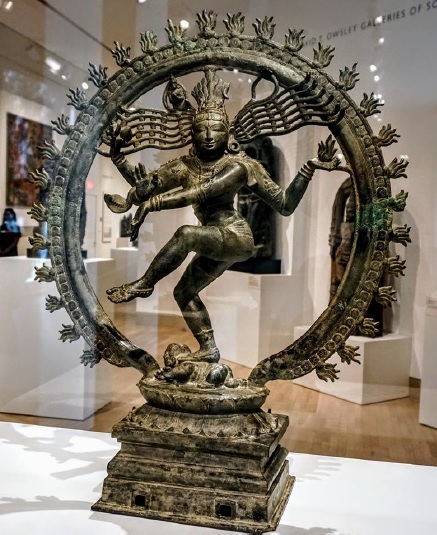
Pic[1] Natarāja. By permission from Shri Raj Mutharasan, Scientist at National science foundation (NSF) and Drexel University
(8) A cobra uncoils from his lower right forearm, while his palm shows the Abhaya mudrā. Abhaya means not to fear, since destruction is the seed of new creation.
(9) The second left-hand points towards the raised foot which suggests the viewer to be active and dance to the circumstances, or alternatively as a sign of upliftment and liberation; liberation from dissolution.
(10) The face shows two eyes plus a slightly open third on the forehead, which symbolize the triune in Shaivism.
(11) The dwarf, on the lotus pedestal on which Natarāja dances, is the demon Apasmāra( Muyalaka, as it is known in Thamizh) Purusha who is the conjunction point of two Makara adjacent on both sides and which symbolizes action and dance that leads to victory over demonic evil or ignorance.
(12) The two Makara at the base creates an overall oval shape around the mūrti. Sometimes it is seen on the summit of the Prabhāsmandal. Makara is a Sanskrit word which means ‘sea dragon’ or ‘water-monster’, a porpoise or a Gangetic dolphin which is similar to Shishumāra [2] of Indic scriptures. In a Hindu temple, the Makara often serves as the structural bookends of a thoranam or archway around a deity. The arch emerges up from the jaws of one Makara, rises to its peak, the Kīrtimukha (the ‘Face of Glory’), and descends into the gaping jaws of another Makara, but they both never meet. Example of Makara anklet is given in a picture below where two Makara (or any other animal head figure) never meets, but still complete a circle at one point.
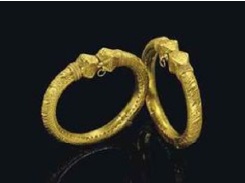
A pair of gold anklets North India with two Makara endings gaping into each other, antique, late 18th cent (courtesy Pinterest; internet)
(13) Natarāja is also known as Koottan in Tamil which has phonetic resemblance with navigational Kootu for Orion as spoken in Kerala. Mṛgaśīrṣa + Ardra Nakshatra makes Orion constellation which is also known as Kālapurusha in Bengal; a reference point for all navigational compass and calendars. In antiquity Kerala, Tamilnadu and parts of southern India were under the domain of Pandya kings.
1.2 Apasmāra; A dwarf demon, and a sleep state.
Apasmāra; the dwarf demon, trodden underfoot lies facing to its proper right in all statues. Apasmāra is facing right, but exceptionally noticed to the left also with a strange shift of leg position of Natarāja. It is depicted as having an anchuli mudra or holding a snake. He is defined as ignorance (known as Muyalaka in Thamizh), and is danced upon which symbolizes Natarāja’s action. The dance leads to victory over demonic evil and ignorance. See pic [3] below.
1.3 Agastya- Canopus.
As a Star; Agastya-Canopus moves fast above Dhruvamandala[4]. There are many scriptural references to Agastya-Canopus being a star starting from Veda, Brāhmanas, Aranyaka[5], Puranas[6], Śruti[7], smṛti, Epics[8], Poetries[9] and Surya-Siddhānta. 359
As a Muni; See pic[10] above; Agastya (Kumbhayoni)-born from a pitcher into which Mitra and Varuṇa dropped their vīrya at the sight of the charms of Urvaśī: a brother of Vasiṣṭha.[11] He had a residence at Malay-Mahāmalaya-(Pothigai)[12]; married the first born daughter of King Malayadhvaja Pāṇḍya, and had a son Dṛḍhācyuta[13], also present at Rāma’s abhiṣeka. [14] Dwarfed the Vindhyas roughly parallel to the Narmada River, made a home in Laṅkā: seeing the universe troubled by Tāraka and other Asuras caused the ocean to dry up by drinking the waters and brought relief to the Devas: performed tapas seated on Mount Malaya with his wife Lopāmudrā: white in colour, with four hands, Akṣa mālā & Kamaṇḍalu, narrated Ajāmila[15] a contemporary of Kṛṣṇa and Rāma; and a resident of Mt. Malaya. Visited by Balarāma. Came to Syamantapañcaka to see Kṛṣṇa, Called on Parīkṣit practising prāyopaveśa etc. Kamban has praised high of Agastya muni as a giver of Tamil grammar. Agastya muni is associated with lord Śiva. Agastya muni was also a dwarf.
Apasmāra means forgetfulness and epilepsy. It represents Agastya when Agastya is not visible from parts of India. Astronomical evidences, are philosophically braided in Indian scriptures, alludes to ignorance and forgetfulness about the star Agastya. It represents a lost memory of an astronomical event, moreover, which has been a neglected part in understanding of Natarāja’s iconography.
Evidence of Natarāja mentioned as a “nartaka” in MBH
Rarest of the thought would ever come to our minds that Natarāja may relate to astronomical phenomena which may be a hypogeal impression for the evolution of “Supreme Cosmic Consciousness” philosophy. The excerpt on Śiva being a Dancer-“nartaka” comes from Śivasahastranāmastrotam from MBH[16] where Śiva is mentioned as a continuous Dancer and who is ardent lover of dance and is continuously dancing. The thirteenth-century Shaiva Siddhāntic text[17] describes Natarāja as sacchidānanda or “Being Consciousness and Bliss”[18]; constantly in dancing state. From nartaka to Natarāja, it has been in the memories of Indian coastal people which come to us through Sangam literature. A verse by Manikavachakar goes, ‘He who creates, protects, and destroys the verdant world…’ Tamil literature gives extract as Pray to Śiva, who owns the South. Pray to Him who is the God of all countries.’[19]
The likely worship of Natarāja by the Pallava period at Chidambaram with an idea of cosmic creation is suggested in Manikavāchakar’s Tiruvachakam which says , ‘Let us praise the dancer (Kuttan) who in good Tillai’s hall dances with fire, who sports (vilaiyatu) creating, destroying, this heaven and earth and all else.’ In essence, it represents the continuous cycle of creation and destruction of time astronomically. Ardra Darshan celebrates this ecstatic dance of Lord Śiva. On this day Lord Śiva becomes Natarāja with reddish fame aura around.
How Śiva as a Natarāja is a creator, protector and destroyer of time through his dance?
Shloka 59[20] says on Śiva being “nakshatra vigraha”/ analyser and “knower of gati”-speed of nakshatras, “layaḥ”-He is the place of deluge thus a destroyer, prajāpati- nakshatraadhipati / sire of all asterisms in sky, which indicates Śiva is the timekeeper of all nakshatras, Vishvabāhuḥ- emanating his arms on all sides (as if to reach out other nakshatras), vibhaagaḥ- He is the seperation, sarvagaḥ-He is the universal soul, amukhaḥ-He who is having no mouth. In astronomical sense He is the point of ending and begining without any celestial logitudinal difference.
There are two unique star clusters which are used as timekeepers and are common in all parts of the world from all the ages. They are 1. Orion 2. Big Dipper. The Orion constellation has served as a timekeeper for eons in every known civilization due to its prominent three waist belt star- Alnilam, Almitak etc and has not changed for thousands of years. In Indic culture the three belt stars are known as Mṛgaśīrṣa Nakshatra. He is also called kālayogī-the one who knows the time/era/eon through yoking. He is the one who generates new loka-world, and He is the only one in which the old world gets dissolved[21]. This evidently speaks of the same point of celestial longitude from where new era starts dissolving the old one. Śiva as a creator is also known from Vishnupurāna which states Raudra-sṛishti[22] nirmāna; at the begining of kalpa Brahma thought of creating a son like ownself and while thinking alone a son of bluish reddish color appeared in his lap.
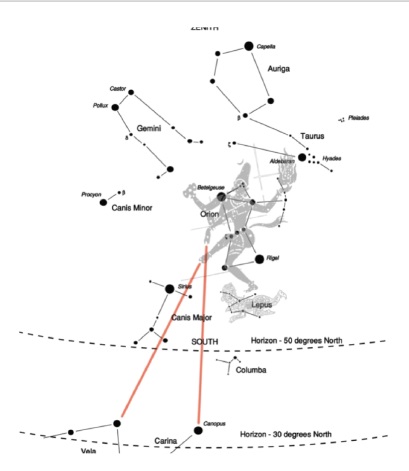
2.1 Natarāja in the sky representing western star cluster Orionis (Indian Mṛgamandal+ Ardra+Mṛgaśīrṣa)
Natarāja’s association with Archaeo-astronomy Let us look at Archaeo-astronomy pieces of evidence related to Dance of Natarāja. But before that let’s understand what Archaeo-astronomy is? It is a scientific discipline that combines mnemonics to know more about the timeline of history, culture, science and technology of observational astronomy with ancient evidence of astronomy references, metaphors and ancient civilizations.
2.1.1 Ardra/Arudra Dārisanam; A living culture and an astronomical evidence from past.
The first eye-catching evidence is Arudra /Ardra darisanam festival of Tamilnadu which is a ten day annual festival in December related to the moon being full in the lunar asterism(nakshatra) Ardra (i.e, alpha Orionis), associated with wrathful aspect of Śiva. On this day Śiva becomes Natarāja or Koothan. In Kerala, the festival is celebrated as the birthday of Lord Śiva. Thiruvathira is the Ardra nakshatra or “star” as per the Malayalam calendar of Lord Śiva. Indeed some astronomical event must have had happened in Ardra nakshatra sometime in past due to which the festival of Arudra Darisanam continues till date. One such is a speculated event of supernovae explosion which has been assumed by many writers. My conjecture would show that it has been related to a new-year beginning on vernal equinox day. We come across another verse in regard of yearly phenomena,-“tasmai te rudra saṃvatsareṇa namaskaromi“[23] This verse serves as a piece of evidence for year beginning with Rudra (deity of Ardra Nakshatra) on the ecliptic node and this was happening around 6000 BCE-5000BCE. Another piece of evidence comes from Shatapatha Brahmana where it has been mentioned ‘with doubt’ whether or not, to kindle a fire under Mṛgaśirśa. This conjecture gives evidence of shifting of vernal point from constellation Mṛgaśirśa and reaffirms that once year beginning was happeing near Constellation Orion. This is also the millennium of Mahabharata war, as established, based on study of 200 Plus astronomy observations of MBH text by Shri Nilesh Oak. It thus makes sense as to why śivasahastranāmstrotram is so revered in MBH texts.
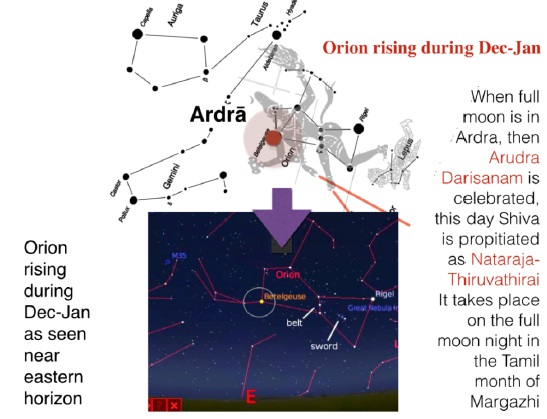 The other memory of wrathfulness of Śiva is of deluge in Pumpoohar near Chidambaram. Enormous evidence exists from around the world for the significant and sudden sea level rise during 6th millennium BCE. Further a question may arise, why Ardra considered on the point of vernal equinox and why not on any other cardinal point? For this again the same shloka from MBH comes to our rescue. Svarbhanu[24], i.e. the ecliptic node as mentioned in MBH. This evidence again affirms samvatsar[25] phenomena and vernal equinox happening in Ardra, from the very same verse which also says Śiva is samvatsakaraH- the maker of the year.
The other memory of wrathfulness of Śiva is of deluge in Pumpoohar near Chidambaram. Enormous evidence exists from around the world for the significant and sudden sea level rise during 6th millennium BCE. Further a question may arise, why Ardra considered on the point of vernal equinox and why not on any other cardinal point? For this again the same shloka from MBH comes to our rescue. Svarbhanu[24], i.e. the ecliptic node as mentioned in MBH. This evidence again affirms samvatsar[25] phenomena and vernal equinox happening in Ardra, from the very same verse which also says Śiva is samvatsakaraH- the maker of the year.
In Malayalam Koothu is the name of Orion constellation used for N-W navigation while in Tamil Kuttan-koothan becomes a name of Natarāja, connection giving pratyaksha-evidence of Natarāja Orion. Once, the whole of South India was under Pandya kings. The evidence of Pandya kings fighting in Bharata War is found in the MBH texts. śivasahastranāmstrotram from MBH is abundant in pieces of astronomical evidence which has been not been explored.
2.1.2 Prabhāsmandal of Natarāja; Orb of Flame and its connection to Mṛga-Mandala
encompassing different stars and star clusters in the vicinity
A comparative study of radiating rays around a human figure in Harappa seal (IVC) Rudra and flame on Chola Bronze Natarāja. Harappa seal (IVC) Standing man who has been identified as Rudra[26] and the adjacent picture of Natarāja, both with orb of flame, affirms pan Indic nature of Śiva. Harappa IVC Rudra is being depicted with radiating arrows/rays upon Prabhāsmandal around the Rudra iconography which is similar to flame marks on the orb of Natarāja statues from southern part of India. This brings evidence on geographical northern, north-western and southern regional connection from primitive times. It is evident that Sindhu-Sarasvati civilization also had an impact of Śiva as Linga which is known to us as one of the significant archaeological find from Harappa and Kalibanga.
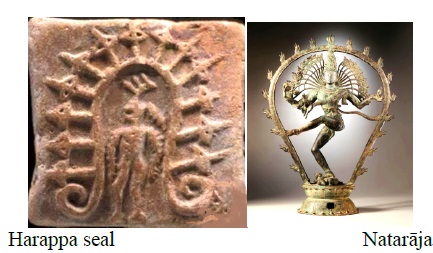 “Prabhāsmandala ”, circle of flames means a circle emanating rays, bhas- “bhāsyati means to make visible”. It is the inkling towards astronomy too which points towards “mṛg-mandala”. While mṛg gamanārthaka from mrij dhātu-verbroot means “to chase”. Therefore, mṛg-mandala stars/constellations, the easiest star cluster percieved via human eyes from prehistoric times, were used to help chase different stars nearby in vicinity like Procyon, Sirius-mṛgavyādha in south and Aurigae in north, Castor Pollux, Plaiedas, Vela, Canopus in their respective directions.
“Prabhāsmandala ”, circle of flames means a circle emanating rays, bhas- “bhāsyati means to make visible”. It is the inkling towards astronomy too which points towards “mṛg-mandala”. While mṛg gamanārthaka from mrij dhātu-verbroot means “to chase”. Therefore, mṛg-mandala stars/constellations, the easiest star cluster percieved via human eyes from prehistoric times, were used to help chase different stars nearby in vicinity like Procyon, Sirius-mṛgavyādha in south and Aurigae in north, Castor Pollux, Plaiedas, Vela, Canopus in their respective directions.
The MBH says “Amongst the Rudras[27] He is the Sire Rudra and amongst the most effulgent Gods He is the prabhā-best illumination”, this connect with prabhā-mandala-orb of flame. It also says “He is the one who achieves or “aims at( different) nakshatras/ asterisms”[28]. Thus, it make sense to equate Prabhāsmandal with astronomical Mṛga-mandala. In the iconography of Natarāja Prabhāsmandal, orb or the circle of flame does help chase other stars in vicinity.
The three parallel horizontal lines drawn using ash/bhasma/vibhuti on the forehead of Śiva devotees with the help of Mṛga-śīrṣa mudra is known as the Tripundra. The thumb and little finger are raised. It springs from Gauri, who used the Mṛgaśīrṣa hand mudra to draw three lines on her forehead when practicing tapas for the sake of Śiva. A mnemonic way to remember Mṛgaśīrṣa three stars from Orion belt. Points above elaborated, discussed and tested concludes Natarāja in the sky as an Astronomical Case.
2.1.3. Why is Harappan IVC seal -Rudra Orion?
 The three emanating lines from the crown of IVC seal , Next pic depics ‘Tripundra mark sparingly used by shavites on their forehead and adjacent right pic depicts Mṛgaśīrṣa mudra’
The three emanating lines from the crown of IVC seal , Next pic depics ‘Tripundra mark sparingly used by shavites on their forehead and adjacent right pic depicts Mṛgaśīrṣa mudra’
2.2 Apasmāra gets overlay upon western constellation Lepus-hare
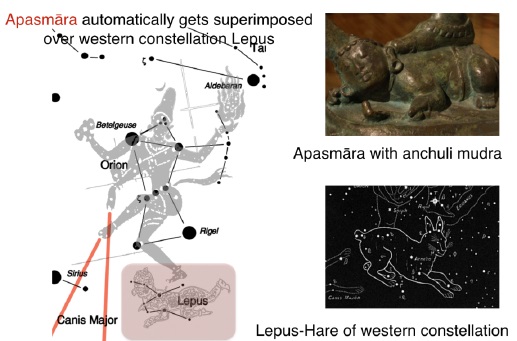 From the above Pic it is found that Apasmāra gets superimposed upon a separate constellation called ‘Lepus’, which is shown trampelled by Śiva-Natarāja, and which rises before Agastya- Canopus during the rising and setting of Orion in the sky. Lepus is also braided in with Hunter constellation from greek iconography similar to Apasmāra braided with Natarāja iconography. This is interesting to note that Lepus constellation of western astronomy alludes Hare iconography which has a connection with moon[29] and Amarkosha says Indu-Saśi-Soma-are names of Mṛgaśīrṣa nakshatra and this has noteworthy resemblance with the meaning of Apasmāra from Ayurveda texts [moon-Luna-lunatic (unpredictable), epilepsy i.e. forgetfulness or ignorance, recollection or consciousness]. It indicates ignorance about the rise of Canopus which is still present in the sky but unseen at some horizon at some point of time.
From the above Pic it is found that Apasmāra gets superimposed upon a separate constellation called ‘Lepus’, which is shown trampelled by Śiva-Natarāja, and which rises before Agastya- Canopus during the rising and setting of Orion in the sky. Lepus is also braided in with Hunter constellation from greek iconography similar to Apasmāra braided with Natarāja iconography. This is interesting to note that Lepus constellation of western astronomy alludes Hare iconography which has a connection with moon[29] and Amarkosha says Indu-Saśi-Soma-are names of Mṛgaśīrṣa nakshatra and this has noteworthy resemblance with the meaning of Apasmāra from Ayurveda texts [moon-Luna-lunatic (unpredictable), epilepsy i.e. forgetfulness or ignorance, recollection or consciousness]. It indicates ignorance about the rise of Canopus which is still present in the sky but unseen at some horizon at some point of time.
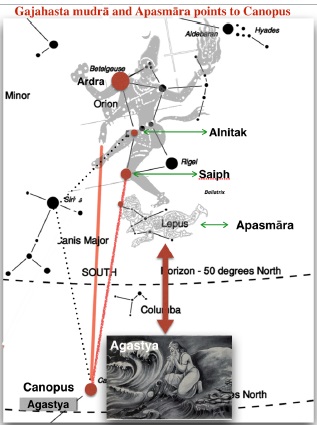
Apasmara with anchuli/drinking mudra is an impression of Agastya indicating loss of memory of it’s rise from certain latitude at certain epoch in astronomical sense. Agastya drinking ocean is an indication to unnravel stars at horizon in relative sense.
3. Cosmic Natarāja has to do with identification of Agastya’s location. All of these have deep connection to ancient Indian tradition of navigation and mobilization. In nutshell, after evaluating the empirical evidence and by testing them, it was found that the latitude of Chidambaram30 was the threshold from where Agastya became invisible while navigating due north away from this latitude when Canopus was at its highest declination, very near to the south celestial pole being a pole star[31]. This astronomical event happened during 11000BCE- 13000BCE. Below Chidambaram latitudes Canopus was always visible. This is tested via computational simulation. However, elaboration of that subject is beyond the purview of this paper.
Conclusion
The paper has comprehensively dealt with each element of Natarāja’s Iconography. It has elaborated and discussed over the inferences drawn, empirically tested and evidences are concluded in regard of understanding of each element of Natarāja’s Iconography. The enigma of Apasmāra is determined via objectively testing of the theory in terms of explanation, prediction and testing with the context of background knowledge. The representation of Apasmāra as an impression of Agastya is proven with loss of memory of an astronomical event which was confined to certain latitude.
Bibliography
- Coomaraswamy, Ananda K., The Dance of Śiva, 1912
- http://en.wikipedia.org/wiki/Meenakshi_Amman_Temple (retrieved 14-05-2012)
- On visibility of Agastya-Canopus in India. By K Chandra Hari
- Folklore and Astronomy; Agastya- a sage and a star by K D Abhyankar
- Professor Southworth, an Emeritus Professor of South Asian Linguists, University ofPennsylvania in his article published in Rice (2011) 4:142-148 notes the deep connectivity of theDravidian languages.*
- When did Mahabharata war happen; Mystery of Arundhati. By Nilesh Oak
References
[1] Pic source; Permission has been granted to publish these photographs from Shri Raj Mutharasan, Scientist at National science foundation (NSF) and Drexel University
[2] Found in Brahmānd Purāna and Vishnu Purāna as one of the northern constellations. archives.org, Gita press)
[3] Published by permission from Shri Raj Mutharasan, Scientist at the US National science foundation (NSF) and Drexel University, USA.
[4] Br. II. 21..
[5] Taittirīya- ĀraNyaka 1.11.2), viśvāmitro jamadagnirbhāradvājo’tha gautamaH|atrirvasishthaḥ kaśyapa ityete saptarishayaḥ ||
[6] Bhā. VI. 18. 5, 28. 32; Br. IV. 5. 38 M. 61. 21-31; 201. 29; 202. 1., Vāyu pu. 48. 23,
[7] saptānām rishīnām agastyāshTamānām yadapatyam tadgotramityācakShate || (Āśvalāyana Śrauta Sūtra; PariśiSTa)
[8] MBH
[9] Raghuvansham XVI.44, in regard of ‘Agastya- chinhād’
[10] Pic source https://en.wikipedia.org/wiki/Agastya
[11] Bhā. VI. 18. 5; Br. IV. 5. 38 M. 61. 21-31; 201. 29; 202. 1.
[12] Vāyu pu. 48. 23
[13] Bhā. IV. 28. 32
[14] 2(a) Vishnu. IV 4. 99.
[15] Bhā., VI. 3. 35; M. 61. 17; 36-41; Br. III. 56. 53.
[16] BahubhutaH bahudharaH swarbhaanuH mitogatiH
[17] Text- Kunchitangrim Bhaje by Umapati of Chidambaram
[18] (Smith 1998: 21).
[19] ‘Thennadudaiya S’ivanae PoRRi, Ennattavarkkum IRaiva PoRRi’
[20] न”#$व&हम)तगु-णबु01धल-योऽगम:।8जाप)त$व-<वबाहु$व-भाग: सव-गोऽमुख:॥५९॥ MBH śivasahastranāmstrotram Anushāsana parva 6th Khanda, 17th adhyāya
[21] यतो लोकाः सEभविGत न भविGत यतः पुनः॥२९॥ MBH śivasahastranāmstrotram Anushāsana parva 6th Khanda, 17th adhyāya*
[22] from Vishnupurāna 8th adhyāya कIपादावाKमनLतुIयं सुतं 8NयायतLतत:।8ादुरासीठाभोरRके
कुमारो नीललोTहत:॥२॥
[23]-“तLमै ते VW संवKसरेण नमLकरोXम”, तै$YरZयकृ\ण यजुव]द संTहता – taittirīyakṛṣṇa Yajurveda saṃhitā5।5।7।3-4
[24] Swarbhānu; name of Rahu, also a name of Shiva,. Rahu is an astronomical mate of ArdraNakshatra
[25] संवKसरकरः॥३९॥ śivasahastranāmstrotram Anushāsana parva 6th Khanda, 17th adhyāya
[26] By Indologist Dr. Rekha Rao
[27] _Wाणम$प यो VW: 8भा 8भवताम$प॥२८॥ śivasahastranāmstrotram, MBH
[28] न”#साधकः॥३७॥ śivasahastranāmstrotram, MBH
[29] Ridpath, Ian; Tirion, Wil (2001), Stars and Planets Guide, Princeton University Press, ISBN 0-691-08913-2
[30] Chitt +ambaram; ambaram in Sanskrit means sky, horizon, compass.
[31] https://en.wikipedia.org/wiki/Pole_star
The paper “Cosmic Consciousness And Astronomical Association Of Natarāja’s Dance With Apasmara And Agastya” was originally presented at Waves 2018 and has been republished with permission.

